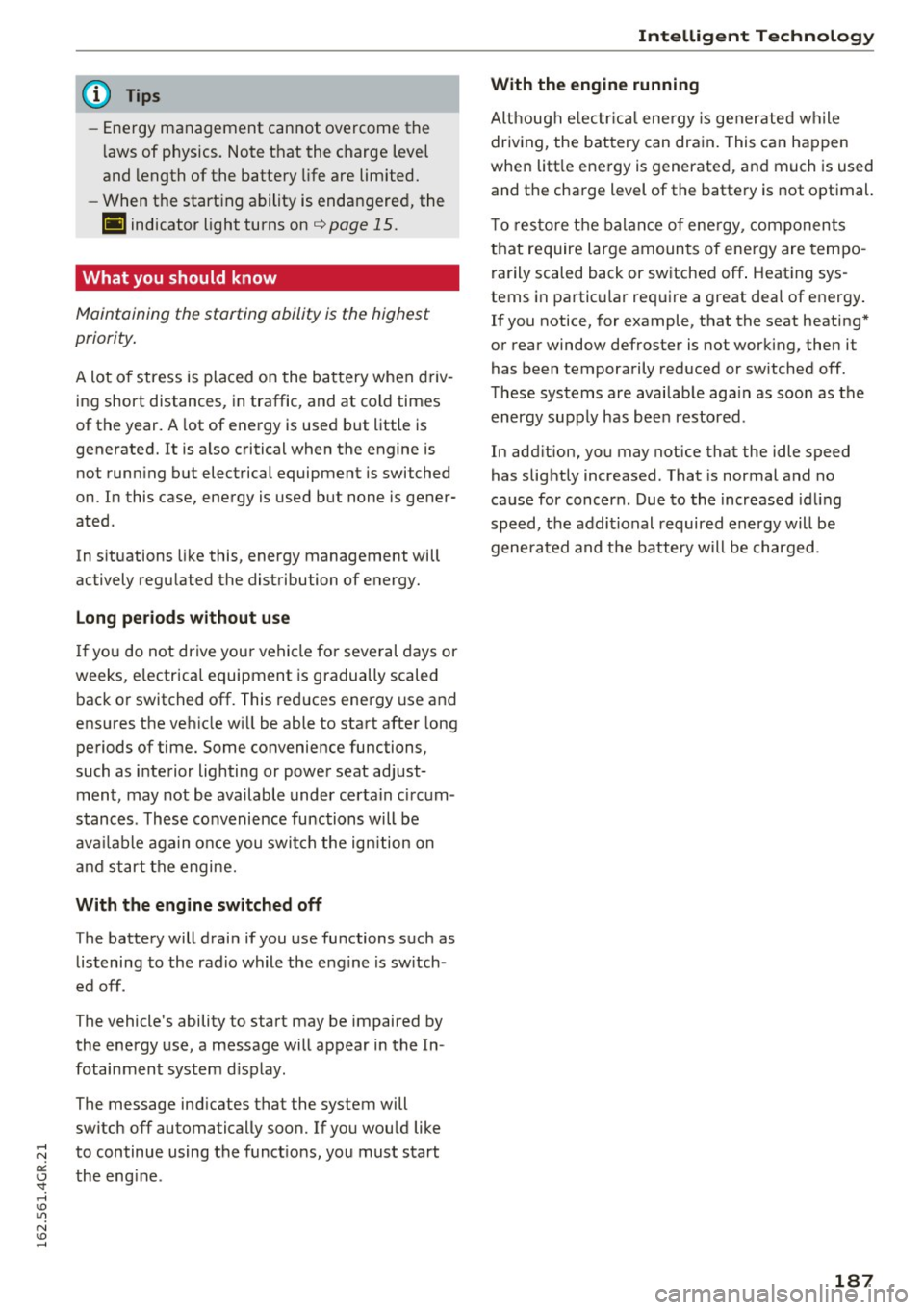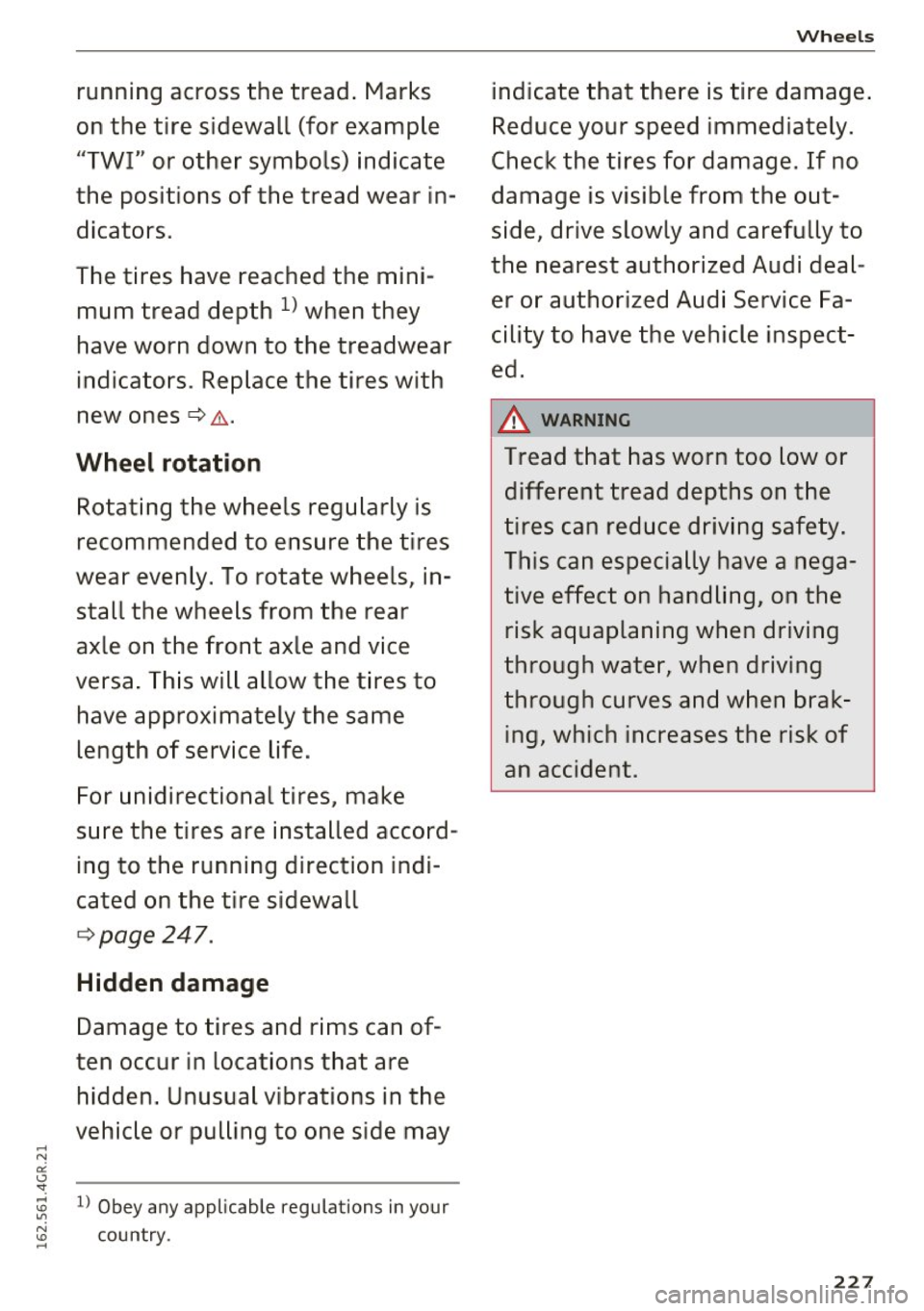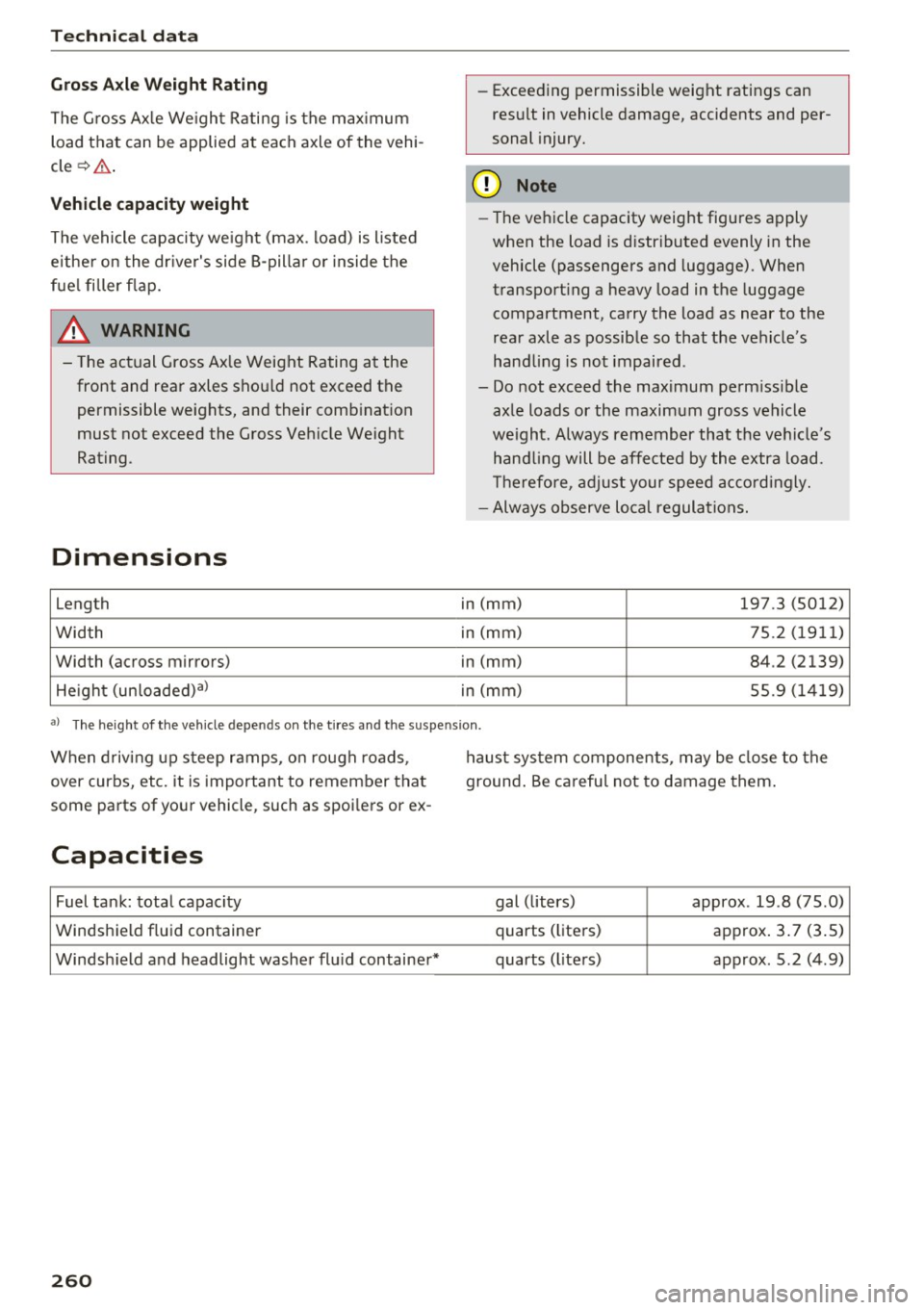2016 AUDI RS7 SPORTBACK length
[x] Cancel search: lengthPage 189 of 282

@ Tips
-Energy management cannot overcome the
laws of physics. Note that the charge level
and length of the battery life are limited.
- When the starting ability is endangered, the
(•j indicator light turns on¢ page 15.
What you should know
Maintaining the starting ability is the highest
priority.
A lot o f stress is placed on the battery when driv
ing short distances, in traffic, and at cold times
of the year. A lot of ene rgy is used but little is
generated. It is also critical when the engine is
not running but electrical equipment is switched
on. In this case, energy is used but none is gener
ated.
In s ituations like this, energy management will
actively regulated the distribution of energy.
Long pe riods without u se
If yo u do not drive your vehicle for several days or
weeks, e lectrica l equipment is gradually scaled
back or switched off. This reduces energy use a nd
ensures the veh icle w ill be able to start after long
periods of time. Some convenience functions,
such as interior lighting or power seat adjust
ment, may not be available under certain circum
stances . These convenience functions will be
ava ilab le aga in once you switch the ign ition on
and st art the engine.
With the engine switched off
The battery will drain if you use functions such as
listening to the radio while the engine is sw itch
ed off.
The vehicle's ability to start may be impaired by
the energy use, a message will appear in the In
fotainment system d isplay.
The message ind icates that the system will
sw itch off automatically soon. If you wou ld like
;:::: to continue using the funct ions, you must start
er: u the eng ine . 'SI: ,....,
With the engine running
Although e lec trica l energy is ge nerated wh ile
driv ing, the b attery can dra in. This can happen
when litt le energy is generated, a nd much is used
and t he charge level of the batte ry is not optimal.
T o res to re the balance of ene rgy, components
that req uire large amoun ts of energy are tempo
rarily scaled back or sw itched
off . Heat ing sys
tems in particular req uir e a great deal of energy .
If you notice, for example, that the seat heating*
or rear window defroster is not working, then it
has been tempora rily reduced or sw itched off.
These systems are availab le aga in as soo n as the
energy supply has bee n restored .
In add ition, you may notice that the idle speed
has slig htly increased. That is normal and no
ca use for concern. Due to the increased id ling
speed, the addi tional required energy will be
generated and t he battery w ill be charged .
187
Page 192 of 282

Driving and th e en vironm ent
- Do not drive until the fuel tank becomes
complete ly empty . The engine cou ld mis
fire . Unburned fuel could also get into the
exhaust system and this cou ld cause the
catalytic converter to overheat.
- Do not sw itch off the ignition while the vehi
cle is moving.
- Do not continue to operate your vehicle un
der these cond itions, as otherwise fuel can
reach the catalytic converter. This could re
sult in overheating of the converter, requ ir
i ng its replacement.
- To assure efficient operation of the Emis
sion Control System :
- Have your veh icle maintained properly and
in accordance with the service recommen
dations in your Warranty
& Maintenance
book let.
- Lack of proper maintenance as well as im
proper use of the vehicle will impair the
function of the emission control system and could lead to damage.
@ For the sake of the environment
Even when the Emission Control System is op
erating properly, the exhaust gas can have a
sulfur-like exhaust gas smell under some op
erating states. This depends on the sulfur
content of the fuel be ing used . Using a differ
ent brand of fuel may help, or filling the tank
w ith lead-free super grade gasoline.
Placing your vehicle out
of service
If you would like to take your vehicle out of serv
ice for a longer time, contact your authorized
Audi dealer or authorized Audi Service Facility.
They will advise you of important measures, such
as corrosion protection, maintenance and stor
age procedures. Also follow the information
about the battery
c:> page 212.
190
Economical and environ
mentally-friendly driving
General
Your personal style of driving will determine the
economy of your vehicle, as well as exhaust and
noise levels.
Fuel economy, env ironmental impact, and wear
on your engine, brakes and tires large ly depend
on three factors:
- your personal driving style
- operating conditions
- technical limitations
If you anticipate what you need to do next and
drive economically, you can easily cut your fuel
consumption by 10-15 percent. This section will
give you some tips on how you can help the envi
ronment and your pocketbook.
(j) Tips
The consumption estimates as published by
ENVIRONMENTAL PROTECTION AGENCY
(EPA) and Transport Canada may not corre
spond to your actual consumption on the road, which will vary depending upon vehicle
l oad and speed, road and weather conditions,
trip length, etc.
Drive smoothly and keep a lookout ahead
Vehicles use the most fuel when they are acceler
ating.
~ Avoid unnecessary accelerat ing and braking .
Vehicles use the most fuel when they are acceler ating. If you anticipate what is going to happen
next, you will need to brake less and, thus, accel
erate less . Let the vehicle coast whenever possi
ble -for example when you see that the next traf
fic light is red.
Page 229 of 282

... N oi '-' ":
running across the tread. Marks
on the tire sidewall (for example "TWI" or other symbols) indicate
the positions of the tread wear in
dicators.
The tires have reached the mini mum tread depth
l ) when they
have worn down to the treadwear
indicators . Replace the tires with
new ones
¢ ,1,. .
Wheel rotation
Rotating the wheels regularly is
recommended to ensure the tires
wear evenly. To rotate wheels, in
stall the wheels from the rear
axle on the front axle and vice
versa. This will allow the tires to
have approximately the same
length of service life.
For unidirectiona l tires, make
sure the tires are installed accord
ing to the running direction indi
cated on the tire sidewall
¢page 247 .
Hidden damage
Damage to tires and rims can of
ten occur in locations that are hidden. Unusual vibrations in the
vehicle or pulling to one side may
~ l) Obey any applicable regulations in your
~ country . ...
Wheels
indicate that there is tire damage.
Reduce your speed immediately.
Check the tires for damage. If no
damage is visible from the out
side, drive slowly and carefully to
the nearest authorized Audi deal
er or authorized Audi Service Fa
cility to have the vehicle inspect
ed.
&_ WARNING
-
Tread that has worn too low or
different tread depths on the
tires can reduce driving safety.
This can especially have a nega tive effect on handling, on the
risk aquaplaning when driving
through water, when driving
through curves and when brak ing, which increases the risk of
an accident.
227
Page 262 of 282

Tech nical data
Gross Axle Weight Rating
The G ross Ax le We ight Rating is the max imum
load that can b e applied at each axle of the vehi
cle ¢& .
Vehicle capacity weight
The vehicle capacity we ight (max . load) is l isted
eithe r on the dr iver's side 8-pilla r or inside the
fue l filler f lap.
A WARNING
- The ac tual Gross Axle Weight Rating at the
front and rear axles shou ld not exceed the
permissible weights, and their comb inat ion
must not exceed the Gross Veh icle Weight
Rating .
Dimensions
length
Width
Width (across mirro rs)
He ight (un lo aded) al -
Exceed ing permissible weight ratings can
result in vehicle damage, accidents and per
sonal injury.
(D Note
- The vehicle capacity weight figures apply
when the load is d istr ibuted evenly in the
vehicle (passengers and luggage) . When
t ransporting a heavy load in the luggage
compartment, carry the load as near to the
rea r axle as possib le so that the vehicle's
hand ling is not impaired .
- Do not exceed the max imum perm iss ible
axle loads or the maximum gross vehicle
we ight. Always remember that the ve hicle 's
han dling will be affe cted by the extra load .
T herefore , ad just your speed ac co rd ingly.
- Always observe lo cal regulations.
in (mm) 197.3 (5012)
in (mm) 75.2 (19 11)
in (mm) 84.2 (2139)
in (mm) 55.9 (1 419)
al The he ight of the veh icle depe nd s on the ti re s an d th e su spensio n.
When drivi ng up s teep r amps , on rough roads ,
over curbs, etc. it is important to remember that
some parts of yo ur vehicle, such as spoi lers or ex -
Capacities
Fuel tank: total capac ity
Windshie ld fluid container
Windsh ield and headlight washe r fl ui d containe r*
260
haust sys tem components , may be close to the
ground . Be ca refu l not to damage them .
gal (liters) approx. 19 .8 (75 .0)
quarts (liters) approx. 3 .7 (3 .5)
quarts (l ite rs) approx. 5.2 (4 .9)